
Embarking on a home remodeling project is an exciting endeavor that allows you to transform your living space to better suit your needs and style. However, success in home remodeling often hinges on careful planning and execution.
In this article, we’ll guide you through 10 essential steps to create a comprehensive home remodeling plan that ensures a smooth and successful project.
1. Planning
Before swinging the first hammer, spend time meticulously planning your home remodeling project. Define your goals, identify the areas of your home you want to renovate, and establish a realistic budget. Research design ideas, materials, and styles to create a clear vision of your desired outcome.
2. Demolition
Once you’ve solidified your plan, it’s time to begin the demolition phase. Remove old fixtures, cabinets, and any elements that will be replaced or upgraded. Exercise caution during this step to preserve the structural integrity of your home and to safely remove debris.
3. Electrical and Plumbing
Address any necessary electrical or plumbing modifications early in the remodeling process. This may involve rerouting wiring, updating outlets, or reconfiguring plumbing fixtures. Consult with professionals to ensure compliance with building codes and to prevent complications later in the project.
4. Framing and Drywall
With the infrastructure in place, proceed to framing and drywall installation. This step defines the layout of your renovated space, including walls and partitions. Ensure that the framing is structurally sound before installing drywall, as this material serves as the foundation for your finishing touches.
5. Painting
Painting is where your vision starts to come to life. Choose colors that complement your design scheme and create the ambiance you desire. Whether it’s a fresh coat for the entire space or accent walls, painting sets the tone for the aesthetics of your remodeled home.
6. Cabinets & Fixtures
Install cabinets and fixtures in areas like the kitchen and bathroom. Pay attention to the functionality and flow of the space, ensuring that the placement of cabinets and fixtures aligns with your daily routines. Select quality materials and hardware for durability and longevity.
7. Doors & Windows
Upgrade or install doors and windows to enhance both the aesthetic and functional aspects of your home. Consider energy-efficient options to improve insulation and reduce utility costs. Properly sealed doors and windows contribute to the overall comfort of your remodeled space.
8. Clean House & Air Vents
Before moving on to the finishing touches, thoroughly clean the entire space. This includes not only visible surfaces but also air vents and ducts. A clean environment is crucial for the health and comfort of your household, especially after the demolition and construction phases.
9. Flooring
Choose and install flooring materials that align with your design preferences and lifestyle. Whether it’s hardwood, tile, carpet, or another option, flooring adds a significant aesthetic and practical dimension to your remodeled space. Ensure proper installation for a polished and enduring result.
10. Trim & Finish Work
Complete your home remodeling project with meticulous trim and finish work. This includes baseboards, crown molding, and any additional decorative elements that tie the space together. Attention to detail in this final step elevates the overall look and feel of your remodeled home.
Conclusion
Creating a comprehensive home remodeling plan involves careful consideration and a systematic approach to each phase of the project. By following these 10 steps, you can ensure a successful remodeling journey that transforms your living space into a harmonious and functional haven.
Whether you’re upgrading a single room or renovating your entire home, thoughtful planning and execution are the keys to a rewarding remodeling experience.
You may also like:- Don’t Buy A House In These 5 US Cities
- A Guide to Prepare for Your First Home Purchase
- A Comprehensive Guide to Saving on Major Appliances
- How to Save on Home Improvement – Cost-Effective Tips for Enhancing Your Space
- Practical Tips and Strategies for Saving Money on Furniture Purchases
- 51 House Cleaning Shortcuts to Save Time and Effort
- 5 Signs of a Good Air Duct Cleaning
- Tenant’s Guide – 5 Things to Remember When You Move In
- 7 Simple Reasons Why You Need a Network Security Camera for Your Home
- Fire Safety Checklist for Home – A Comprehensive Guide








